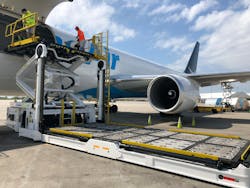With decades of experience producing electric and alternative powered ground support equipment, JBT has applied this know-how to cargo handling equipment.
The C30i E electric powered main deck loader debuted in 2018. Later this year, the company will start production on a new variation with an extended range.
The Commander 30i E is part of the company’s continued push to make clean energy versions for all of its products, explains JBT's Kevin Cecil, engineering manager - loaders, and Gary Walter, ground support equipment regional director - the Americas.
“The Commander Cargo Loader lineup has electric versions of the C15i and C30i available today. C40i and C60i will be part of the continued development in the near future,” Cecil and Walter say.
“The Ranger Cargo Loader is also available in electric and we have also done a trial with a hydrogen fuel cell in place of a battery as a proof of concept.”
By moving to electric products, JBT officials are seeing more efficiency, less use of power, less emissions and lower maintenance costs.
However, Cecil and Walter notes that all new developments come with challenges, including engineering development, supplier lead-times and more.
“One place we can see a need across suppliers is for better standardization of charging connectors, message protocols, etc., to allow customers to have options that work regardless of the OEM, batteries or chargers they choose to utilize,” Cecil and Walter say. “This is an opportunity for the industry to come together and set standards for this via SAE, IATA, CE, CAAC or others as needed.”
Moving forward, JBT is looking to integrate common design principles and components across all of its products, according to Cecil and Walter.
“This will allow for better component utilization, better reliability, and will also help with maintenance and training for customers,” they say.
Beyond its electric offerings, JBT started production on the Falcon Cargo Loader in 2020. The Falcon was launched as more containerized regional aircraft became prevalent in the industry versus traditional bulk load configurations, Cecil and Walter explain.
“With the ATR, Cessna and CRJ filling a new spot with smaller aircraft, lower door heights and minimal containers and lower container weights, the traditional dual platform cargo loaders were too big for this application and a new ground up design was needed,” Cecil and Walter say.
“By moving to containerized cargo, more synergies can be found in the freight network and handling,” they add. “It is also better for all weather conditions and can increase the speed of the onload/offload.”
About the Author
Josh Smith
Editor
Josh Smith served as editor of Ground Support Worldwide as editor from 2016 through 2024. He oversaw production of the print magazine, created GSW's newsletters on a daily basis, and updated the latest news on AviationPros.com.

